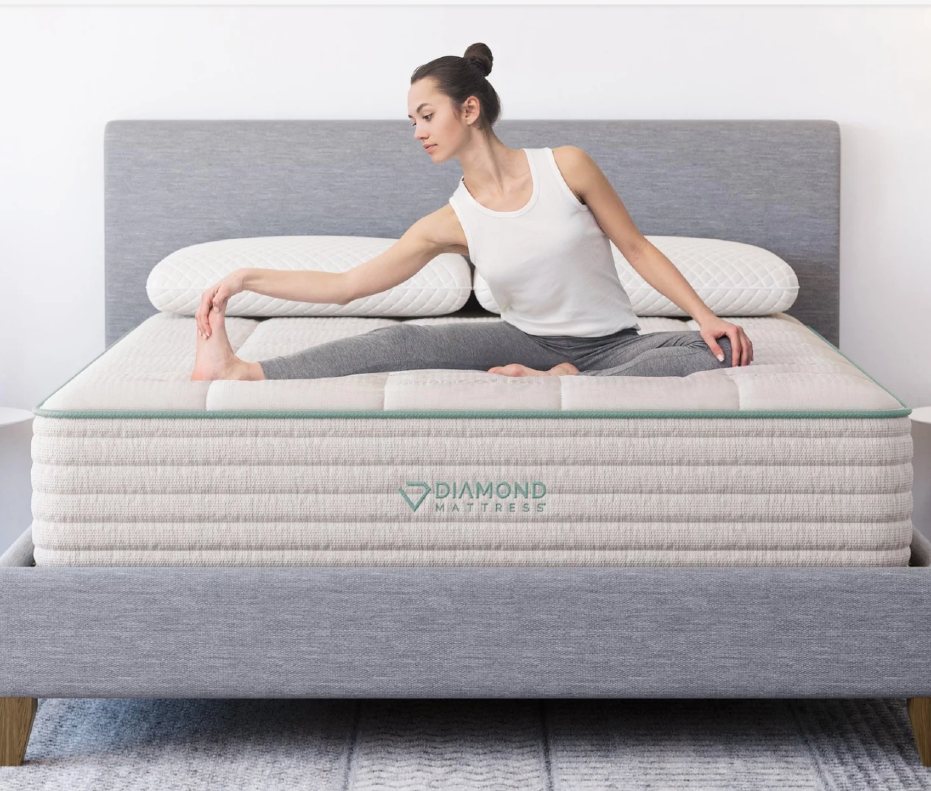Best Latex Mattress Reviews 2024: Expert Reviews By 25 Year Mattress Manufacturer
The best latex mattress options are an alternative to polyurethane foam (memory foam) mattresses and are highly beneficial for pressure and pain relief and spine support. They are also chemical free, hypo-allergenic, and resist gulleys and indentations.
After spending 25 years as a mattress manufacturer, specifically designing latex mattresses, I’m going to highlight 10 features and benefits of latex beds that distinguish them as compelling alternatives to memory foam and other types of mattresses.
- Natural Comfort: Latex mattresses are made with botanically derived material vs. petrochemical ingredients, offering a plush yet supportive surface that conforms to your body’s contours for optimal comfort.
- Pressure Point Relief: The inherent elasticity of latex helps relieve pressure points, reducing discomfort and promoting restful sleep.
- Durability: Latex is exceptionally durable, ensuring that your mattress maintains its quality and support over time. It does not breakdown or pill after exposure to UV light, like memory foam and has a much longer lifespan.
- Breathability: Latex is naturally breathable, allowing for effective air circulation and heat dissipation during sleep. It is more “open cell” in structure, and does not get rigid and uncomfortable when exposed to low temperatures.
- Hypoallergenic Properties: Naturally resistant to dust mites and other allergens, latex mattresses are an excellent choice for allergy sufferers. It is also odor free and does not “off-gas”.
- Environmentally Friendly: Derived from the sap of rubber trees, latex is a sustainable and renewable resource.
- Motion Isolation: Latex minimizes motion transfer, ensuring that movements from your sleep partner do not disturb your rest.
- Customizable Comfort: Many latex mattresses are designed with customizable layers, allowing you to adjust firmness levels for personalized comfort.
- Natural Materials: Organic latex mattresses are made from materials certified as free from harmful chemicals, providing a healthier sleep environment. There are no VOC’s, heavy metals, PBDE’s, or formaldehydes present in botanical latex.
- Temperature Regulation: Latex’s open-cell structure promotes better airflow, helping to regulate temperature and prevent overheating during sleep.
Naturally Anti-Microbial, Fragrance Free, And No Off-Gassing
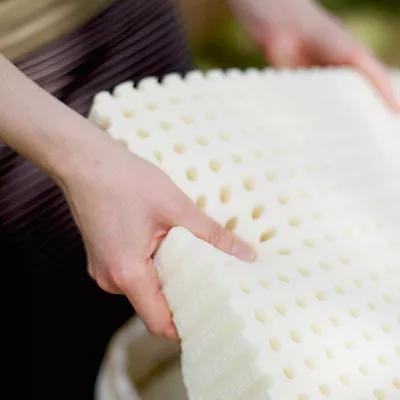
The best latex mattress mattresses are truly the only chemical free, non-toxic material that you can sleep on. I get a lot of questions from people with chemical and fragrance sensitivities, allergies, and compromised immune systems, looking for help.
Because of its hypoallergenic properties, it’s often the last option available for people who can’t cope with the off-gassing and fumes often associated with memory foam mattresses and other all petroleum based foam beds.
An article in Medical News Today explains the differences between sleeping on natural latex vs. memory foam and warns about the off gassing problems posed to sensitive individuals.
Natural latex, unlike synthetic polyurethane foams commonly used in mattress making, has inherent antimicrobial properties, which means it naturally resists the growth of microbes, such as bacteria, mold, and mildew. There are several reasons why natural latex exhibits these antimicrobial properties:
- Latex Composition: Natural latex is composed of a unique blend of organic compounds, including proteins, starches, and oils. These compounds, along with the physical structure of latex, create an environment that is inhospitable to many types of microorganisms.
- pH and Moisture Regulation: Latex has a slightly acidic pH level, typically ranging between 4 and 5. This acidity helps inhibit the growth of microbes, as most microorganisms prefer a neutral or alkaline environment. Additionally, natural latex has the ability to regulate moisture by wicking away excess moisture and promoting better airflow. Moisture control is crucial in preventing the growth of mold, mildew, and bacteria, as these organisms thrive in damp environments.
- Allergenic Protein Reduction: One of the reasons latex is naturally resistant to microbes is because of its unique proteins, which can have an antimicrobial effect. However, some individuals can develop allergies to these proteins, known as latex allergies. To minimize the risk of allergic reactions, latex used in mattresses typically undergoes a thorough washing process to remove a significant amount of the allergenic proteins, making it safe for most people.
It’s important to note that while natural latex has inherent antimicrobial properties, it is not completely immune to microbial growth, but offers relief for many people suffering with allergies by calming their immune systems.
Keep your latex mattress clean and hygienic. This means making sure you do things like maintain a clean mattress protector, and washing your sheets and pillow cases frequently.
Additionally, if you have specific concerns about allergies or sensitivities, it’s advisable to consult with a healthcare provider.
natural latex is hand collected as a liquid then converted to solid form
To make a natural latex mattress, pure botanical latex in liquid form is collected on sustainable plantations, typically in Asia, South America, and Sri Lanka.
Trees are tapped by hand by the thousands, and the liquid latex is harvested, poured into large vats, then trucks transport the raw latex “milk” or “sap” to nearby production facilities that process the latex.
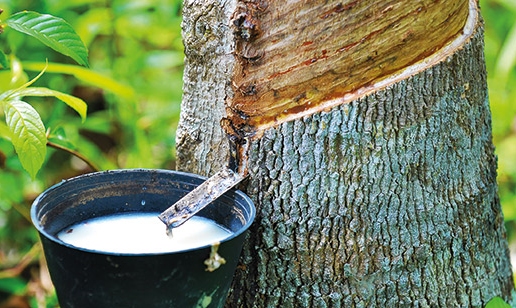
To be converted into conventional mattress sized “cores” that are about 6″ thick, the liquid latex is whipped with bubbled air create a frothy mixture.
The mixture must be rapidly heated with steam to prevent scorching, and the liquid mixture converts to a solid material in a process called vulcanization.
This is the same process used to make most rubber products, including automobile tires, latex exam gloves, and rubber compounds used in various industries.
The liquid latex rubber is poured into what resembles giant Belgian waffle irons with multiple pins that rapidly spread heat to cause instant solidification without burning the latex.
There are actually two different methods of latex processes, one of which is called The Dunlop Method, and the other called The Talalay Process.
Each is similar, but Talalay latex involves a flash freeze step that instantly suspends much smaller air bubbles in the mixture just before it is solidified under intense steam pressure.
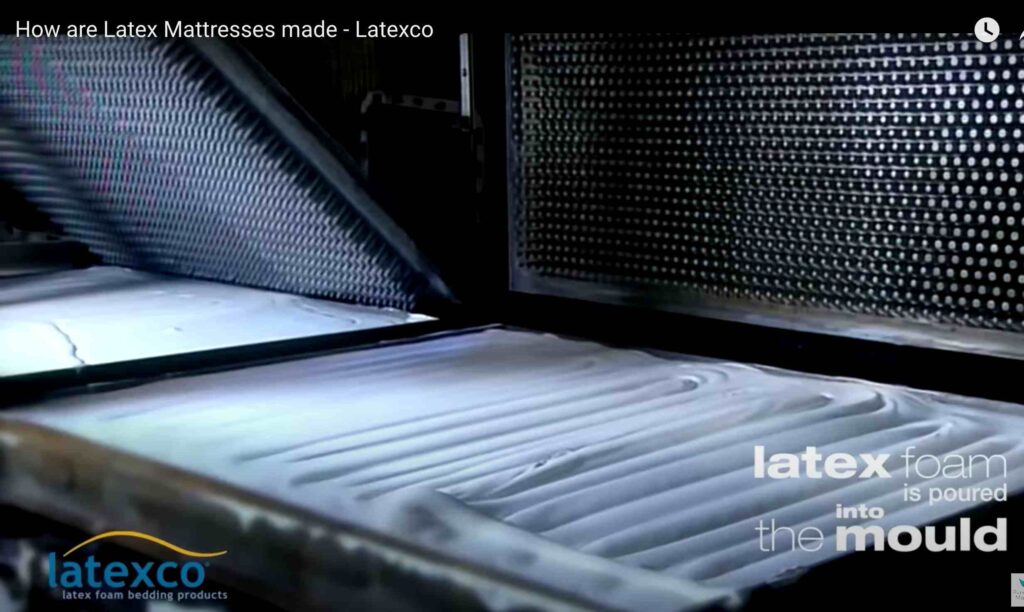
You’ll see Talalay latex being marketed as superior, however my personal opinion is that they both feel so similar that it would be difficult to tell them apart unless you were an expert. We’ll get into some more in-depth detail below, if you want to learn more. You can also check out more resources about natural latex on our site here.
WHY A NATURAL LATEX MATTRESS IS HEALTHIER, SAFER, AND BETTER FOR YOUR BACK
Many people have had serious skin reactions from memory foam and other petroleum based foam products that contain formaldehyde, heavy metals, VOC’s (volatile organic compounds that emit fumes), and other substances.
Did you know that natural latex is the only bedding material that resists dust mites, mold, and mildew? Due to its acidic pH, many harmful organisms simply cannot live inside, or even near, a pure botanical latex mattress.
The catch is, though, that you have to make sure you are buying a pure natural latex mattress, and not one that contains a synthetic, so-called latex, made from SBR, or styrene butadiene rubber- a petroleum based compound.

Natural latex has more springiness, faster response time, and won’t cause your spine to bow or arc, unlike memory foam mattress, or really hard polyurethane foam mattresses.
Because natural latex rubber is spongier but also springs back fast, it tends to push upon your body and has a floatation like effect, which also means less pressure on your back, neck, hips and shoulders.
Natural Latex Is 100% Plant Based, Is A Sustainable Product, And Can Last 50 Years
Because it is a plant based, natural material that contains no petroleum based products, botanically derived natural latex has become one of the most popular options for bedding, especially for folks who are looking for the healthiest mattress they can find.
There are dozens of companies selling latex mattresses, but how do you choose the right one? Why would you buy one vs. a conventional mattress like an innerspring, or a memory foam mattress? And which brands are better than others?
Read on to discover everything you need to know about latex mattresses, and we’ll arm you with all of the information you need. I’ve seen latex mattresses make a roaring comeback in the last few years as awareness of chemicals inside of mattresses has taken center stage.
I think a lot of it has to do with consumers searching for mattresses that are cleaner and greener, made using safer ingredients that don’t contain petroleum base ingredients.
It’s also an extraordinary material too, being highly responsive, cradling and soft without that sinking in sensation that memory foam delivers, it’s resistant to dust mites, mold and bacteria, and it’s very sturdy, not prone to bucketing or depressions. Natural latex, especially, outperforms almost every other kind of foam with regards to durability and lifespan.
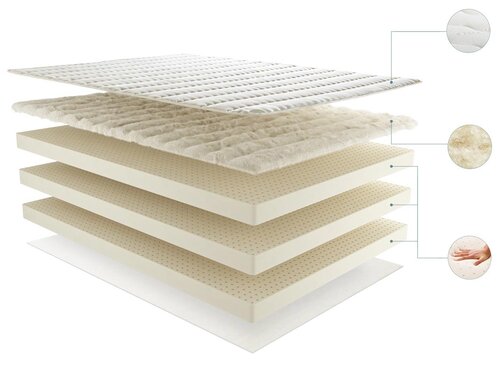
A natural latex mattress is made using successively softer layers of latex from bottom to top.
Firmer layers beneath help establish the lateral pressure distribution that spreads weight and load sideways rather than in a hard, downward, pinpoint direction.
Pure, botanically derived latex is naturally anti-microbial, resists dust mites, mold, and mildew, primarily because of its pH, which is inhospitable to many microbes, dust mites, and mold spores.
In fact, the video below will reveal how a block of pure latex rubber looks after 50 years, with no mildew, mold, discoloration, or even loss of texture and squishiness a half-century later.
Truly, natural latex is the most pain-relieving and naturally supportive material whether you are a back, side, or even a belly sleeper!
And, a natural latex won’t rot or dry out over time like other foam mattresses. Check out this video, filmed by the Arizona Premium Mattress Company, that shows a fifty-year-old natural latex mattress being cut open. It’s almost unbelievable to think that after half a century, the pure latex foam inside is still in perfect condition.
Interestingly, latex mattresses have in fact, been around since the 1950’s, and many Americans grew up on Sears latex mattresses, which were carted home by the millions as the baby boomer generation was coming of age.
It can be synthetic, a blend of natural and synthetic or all natural, but in any form, it is bouncy, elastic, stretchy, yielding, and you don’t get hot, and you don’t have to dig your way out of it.
Latex mattresses offer excellent pressure relief, and distributes weight loads laterally, or sideways, rather than straight down. That’s what provides the unique, signature floating like sensation you feel with pure latex.
It’s excellent for side sleepers, back sleepers, or belly sleepers, because it pushes up against your body rather than permitting it to sink, it doesn’t sleep hot, and it is highly effective at relieving pressure because it effectively pushes weight to the edges of your mattress.
You can buy natural latex or the synthetic variety, and they tend to be indistinguishable, although folks looking the botanically derived variety can find it several places online.
A pure, botanically derived latex mattress, or a natural latex mattress, also has many added benefits that petroleum based mattresses do not. Natural latex is anti-microbial, repels dust mites, will not turn yellow and begin to crumble over time like polyurethane foam beds will always do, and will not develop indentations or ruts over time. It also has no detectable odor.
For quality of sleep, Natural Latex allows you to effortlessly roll from side to back or side to belly, which prevents disruption of natural sleep patterns. Side sleepers, or people who toss and turn tend to sleep much more deeply in consistent REM sleep, because latex properly supports and floats your body.
It effectively relieves pressure points by spreading load horizontally rather than downward like cheap urethane or high density slab foams, increasing pressure and pain.
And, if you buy a pure latex mattress from a smaller, boutique vendor without a lot of overhead, you’re going to get a better bed, because they don’t need to compensate all of the middle men, distributors, and factory reps, who drive mattress prices through the ceiling.
Latex is made using a very unique process called vulcanization, meaning using steam to rapidly solidify the liquid foam into the wonderful, jiggly solid version. We’ll get into the nitty gritty on that below.
How To Shop For A Latex Mattress…What To Look For
If you start shopping for a latex mattress, you’ll want to know a little bit about foam density to feel a bit more confident when talking to sales people. The unit of measurement which gauges the softness or firmness of natural latex is ILD (Indentation Load Deflection), which is a term that’s tossed around a lot, but don’t be intimidated by it, as it is the one tool you can use to compare one manufacturer’s mattress to another.
It basically is the amount of weight it takes to depress a piece of latex one inch when one square foot of weight is placed on it.
Most manufacturers use natural latex ranging from 18-19ILD for a softer feel at the top, and 26-30ILD for a firmer feel on the bottom, but often manufacturers use combinations of various layers to create more specific sensations of support. Many times, these ingredients and their combinations are trade secrets with many companies.
Two Options: All Latex Top To Bottom, Or Hybrid Version With Latex And Pocket Coils
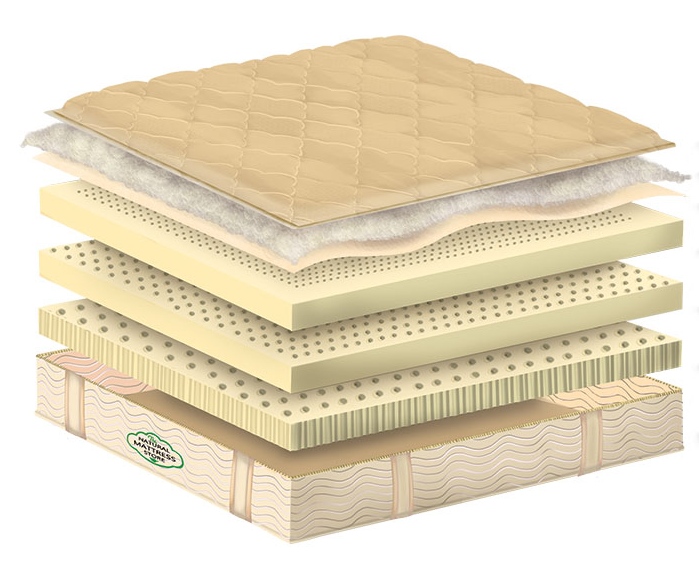
An all natural latex mattress can be more expensive than conventional options because of the increased cost of botanically derived latex which has to be imported.
It is only grown and processed in specific climates, and has to be hand made. The individual “core” layers are then shipped to manufacturers in the USA for assembly into specific models, each of which has various performance qualities, and degrees of softness or firmness.
Natural latex can be created in an array of densities by controlling the amount of air that is bubbled into the mixture during the solidification process.
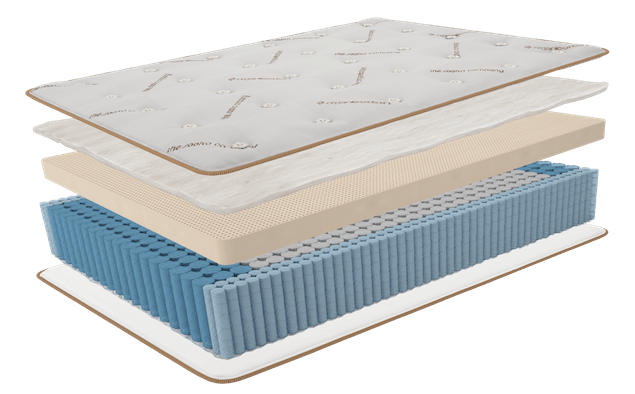
Latex hybrid mattress options are becoming increasingly more popular and I’ve tested and reviewed several that offer the highly responsive, bouncier feel you get with latex, along with the support you need with a pocket coil suspension.
For couples, bigger bodies, and for intimacy, a natural latex hybrid is a great option. Edge support is generally improved quite a bit with a hybrid version as well.
We’ve included several below in our list of best natural latex options. Generally, they are a little less expensive than the 100% all natural top to bottom versions since you save on the cost of multiple layers of natural latex.
Also, many people get concerned about allergies from being exposed to latex. Synthetic latex and natural latex both tend to be hypo-allergenic, and far more people have negative responses to urethane (memory) foams that latex, because of chemical sensitivities rather than allergy issues.
And, there are now companies who are creating mattresses designed to be more price sensitive by offering a hybrid mattress, which will have a section of latex on top as the comfort layer, and a supportive base layer which provides the foundation for the mattress.
Though we generally recommend a pure latex mattress that is made without coils or other types of foam, there are a few excellent latex and coil combinations, including The Nolah 11″ Latex Hybrid Mattress. Because of the popularity for hybrid mattresses that offer better support and longer lifespan, mattresses using natural components adds to their features and benefits.
In the hybrid version of a latex bed, the supportive base layer is typically a piece of stiffer polyurethane foam, which doesn’t offer the top to bottom elasticity and buoyancy that a pure latex mattress offers, but they are typically less expensive.
The best latex mattress options will generally offer a 3-4″ piece of natural latex above the pocketed coil section of a hybrid mattress, which render a more responsive and “rubbery” sensation with elasticity and bounce factor.
My best latex mattress recommendations include some hybrid versions, but- if you opt for a 100% latex mattress, you’ll get more benefits overall, including the anti-microbial, anti-dust mite, and anti-fungal qualities that only botanical latex can offer.
Look For Brands That Properly Laminate Individual Layers Together
Very importantly, I recommend a company that laminates or glues their layers together using a non-toxic adhesive. Many companies reduce manufacturing costs by selling a latex mattress with unglued layers, which contains several layers that stack one on top of the other, the benefit being that you can swap out the positions of each layer to customize the feel of the mattress. You’ll have less issues with “content migration” down the road, though, if you opt for the glued layer option.
It all sounds good until you get this bag full of layers of latex delivered, stack them inside the accompanying bag, and sleep on it for a few nights. You’ll find yourself unzipping the cover, and constantly restacking and realigning the layers because of shifting during the night.
I suggest buying a finished product. I’ve read a lot of complaints about these kinds of beds, and because latex is highly flexible and stretchy, it only makes sense to buy something that is properly glued together to prevent migration and shifting.
THE BEST LATEX MATTRESS OPTIONS WILL INCLUDE A DECENT TRIAL PERIOD AND A 10-15 YEAR WARRANTY
Since there are so many choices on the web selling latex mattresses, it all comes down to a few things to consider- but without a doubt, the best choice, usually has something to do with a money back trial. Most companies now offer them, typically 90 or 180 day trial periods.
Look for a company that gives you the longest amount of time, and allows you to return the mattress for whatever reason, without questions.
Most importantly, find a company that has strong BBB ratings, preferably an A rating, with good third party reviews. If you have chemical sensitivities, allergies, or are prone to get headaches caused by fragrances or odors, a natural latex mattress, top to bottom, might be your best choice. Migraine sufferers also tend to do very well on a latex mattress.

Botanically derived latex stays flexible and will not harden unlike synthetic latex and allows you to effortlessly roll from side to back or side to belly, which prevents disruption of natural sleep patterns.
Side sleepers, or people who toss and turn, tend to sleep much more deeply in consistent REM sleep, because natural latex properly supports and distributes weight, relieves pressure points by spreading load horizontally rather than downward.
Memory foam and polyurethane foam generally do not provide as much lift or upward support as natural latex.
Pro Tip: Choose a medium to medium firm latex mattress over plush. Softer latex mattresses can make it difficult to change positions or transfer in and out of bed.
How Natural Latex Is Harvest And Processed
Harvest from a tree called Hevea brasiliensis on plantations in Sri Lanka, India, Viet Nam, and occasionally in South America, raw, liquid latex is converted to solid form using a unique technique, called vulcanization, which employs massive Belgian Waffle style machines using steam to rapidly solidify the liquid foam into the jiggly solid version.
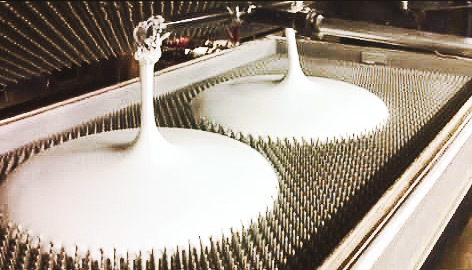
The most time tested and standardized technique is the Dunlop method, which yields a more supportive and slightly firmer latex, ideal for bottom layers that provide underlying support. The Dunlop method of solidifying latex has been around for 60 years, and you can find Dunlop mattresses still out there today that are in perfect, factory like condition.
The newest technique, called the Talalay process, is essentially the same general technique, except it includes a flash freeze step which suspends smaller air bubbles in the mold immediately before it is rapidly heated to solidify the latex, resulting in a slightly softer, but equally supportive feel. Ideal for those top comfort layers and provides a softer, cushier, and wonderful velvety finished feel.
As a side note, many people get concerned about allergies from natural latex. Both synthetic latex and natural latex both tend to be hypo-allergenic, though the pure, natural version is ideal, and because it is typically rinsed with drinkable water and squeezed multiple times after it is manufactured, the small, powder size latex proteins that cause latex allergies are washed away.
Understanding The Difference Between Talalay And Dunlop Latex
Our latex mattress reviews make shopping for pure latex mattresses a bit easier, especially considering there are far fewer options than the mass produced synthetic foam beds that are now flooding the marketplace. You’ll find that there are two different “types” of latex. Keep in mind that they are made from exactly the same sources.
Liquid latex is tapped from rubber trees, collected and transported to large facilities where the liquid rubber is heated up in what looks like a giant, steam powered Belgian waffle press, where it is vulcanized into a solid. The solid form is the finished product, and retains its jiggly, giving, buoyant, and uplifting characteristics that make it so desirable.
Dunlop latex is the most tried and true method of making latex cores, or the rectangular blocks that are cut into various sizes. It is converted straight from liquid to solid, rinsed, squeezed, and then sent off for production. Talalay latex starts out the same way, but the ovens are equipped with a flash freeze apparatus that immediately solidifies the latex after it has been vulcanized by steam into its solid form.
This allows for greater control over the bubble size that forms in the Talalay material, thus allowing the manufacturer to better control the densities and formulation. That is why Talalay makes a better top layer, or direct body contact layer, since it can be of varying precisely controlled densities.
Dunlop latex, because it is the battlefield tested variant of natural latex (as shown in the above video) make an ideal base layer to the perfect latex mattress.
Also, there are now companies who are creating mattresses designed to be more price sensitive by offering a hybrid mattress, which will have a section of latex on top as the comfort layer, and a supportive base layer which provides the foundation for the mattress. These are also worth looking at, though, if you can spring for an all latex mattress, since you get more of the good stuff top to bottom.
Natural Latex vs. Memory Foam
If you’ve just your quest for the perfect mattress online, you’re probably looking at a lot of foam beds, including the big name “bed in a box” brands that chase us all over the internet, on social media, and even to our offices and homes. One think you may not notice, that I do, from being in the bedding business for more than 20 years, and inventing and designing, then marketing and selling dozens of foam beds online myself, is that they are kind of all the same.
A big slab of polyurethane foam on the bottom, padded with a really cool mint green layer of memory foam, which is still polyurethane foam, and then another layer of “graphite infused” cooling gel foam, which is, you guessed it, yet another slab of polyurethane foam. There are probably 50 of them that are prominently featured in search results on Google, and they basically all feel the same.
Did you ever consider that all of these beds are made from petroleum based materials, and are glued together with a petroleum based adhesive? Wrap it up in a polyester cover and you’ve got what I call the perfect chemical bed. I’m not going to say they are toxic, though in my years selling pure latex beds I spoke to many people with allergies to synthetic foam, formaldehyde based adhesives, and smell sensitivity, who would tell me often, “I had to return my polyurethane mattress because it was making me sick and giving me hives”.
If you are sensitive to chemical smells, or breakout in strange rashes when exposed to bedding products, synthetic clothes, and you are looking for a safe, clean, “non-toxic” mattress. I urge you to consider an all natural latex mattress.
There are a few different reasons behind the rising interest in all natural latex mattresses. One theme we hear is from people interested in a “green” mattress option. This can include those that want a mattress made of all natural ingredients, those wanting to buy a mattress made from sustainable materials, or those that want to assure that their bed isn’t off gassing any unnatural materials into their bedroom.
And while there are other materials that offer some of these “green” qualities, such as organic cotton or wool, none of them have the same buoyant and elastic characteristics that a latex mattress offers.
Cotton mattresses, much like futon mattresses, pack down over time and get much firmer, and while wool makes a very nice comfort layer, you still need a good mattress “core” or base, to layer the wool on top of.
Others find Natural Latex interesting because of its hypo-allergenic, anti-bacterial, and anti-dust mite qualities. These organisms do not thrive in natural latex, and it’s the only bedding component that has these amazing qualities. Almost everyone is allergic to dust mite feces and egg casings, which accumulate very quickly in polyurethane foam, mixed with moisture. The only dust mite free sleep surface is an all natural latex mattress.
And finally, there are a fair amount of people that just haven’t been able to find a comfortable bed. Since all of the popular polyurethane foam beds basically feel the same and do not offer anywhere near the pressure relieving qualities and buoyancy and levitating feel that only pure latex offers, why are they even considering them as an option? Often they have specific pain issues they are trying to address, but others have tried all sorts of other mattress options and just can’t get a good night’s sleep.
And the truth is, that despite all the hype in the industry about latex, it really is a great option for these different kind of customers. There is no “greener” mattress than an all natural latex mattress, and it can be a very effective choice for those that have chemical sensitivities or other allergy concerns.
The most important reason latex has become the current “hot” product, though, is that it is a uniquely comfortable sleep surface. Latex is both a very dense surface, but also because of its elastic properties, still has a yielding, giving, and conforming quality. So for those that just haven’t been able to get a good night’s sleep or have unrelieved pain issues, a latex mattress is a top of the line alternative that has a very different feel, offers unparalleled comfort and support, that may well do the trick.
ALL LATEX MATTRESSES AREN’T CREATED EQUAL
Be warned, though, that not all mattresses called “latex mattresses” are the same. How can this be? Well, it is a long story that boils down to this – synthetic latex was created during World War II (to help deal with shortages of the natural latex needed for the war effort), and these days a mattress is considered latex regardless of whether it is made of natural latex (made from the sap of the rubber tree) or of synthetic latex (made from petrochemicals), or more commonly a mix of synthetic and natural latex (referred to, in the industry, as a “blend” of latex).
Why should you care about this? Well, if you are interested in a latex mattress because of its “green” or natural properties, you would want to make sure that the “latex” mattress you are looking at is made of natural, plant derived latex (rubber tree sap) and not chemicals.
Further, while natural and synthetic latex may look the same under the microscope, in real life they have somewhat different feels and, some claim, differing levels of durability (although, to be honest, I’ve heard the natural and synthetic latex purveyors both argue that their product is more durable, and not having a degree in chemistry I just don’t which side has the more compelling argument).
8 Point Best Latex Mattress Shopping Guide
Ok, so in a nutshell, here are my 8 Bullet Points to consider when shopping for a great latex mattress. These are the important considerations you should be looking for to get a decent deal on a well crafted latex mattress.
I prefer 100% natural latex over synthetic or blended beds — natural latex just has a livelier, more responsive, and has more elastic qualities than the synthetic or blended mattresses. Natural latex just has a more comfortable feel. In addition, natural latex, is durable, resists packing down and forming body impressions. It offers other advantages that the synthetic Latex doesn’t have, such as the naturally anti-dust mite, anti-mold and anti-mildew qualities, the hypo-allergenic qualities, and it is a chemical free bed that will does not off gas.
Look for simplistically designed, uncomplicated natural latex mattresses. This will minimize problems with shifting layers and migration of contents. Avoid mattresses with excessive zones or “cut up” designs.
Dunlop natural latex on the bottom, Talalay natural latex on the top, if you are going to go for a mattress with multiple layers. The Dunlop layer provides a good foundation or substrate layer, offering support, while a Talalay latex top layer offers a luxurious feel to the mattress.
Look for a breathable outer covering, preferably a wool blend that contains no chemical fire retardants. Also, the covering should not be excessively thick or quilted, so that you remain in close contact with what you are paying for…latex.
Buy from a reputable company, with easily accessible, independent third party reviews, so you can read what other people are saying who have already purchased latex mattresses from this company. That way, you can avoid the litany of trials and tribulations I often hear about from people who have spent a lot of money on a mattress, only to find that if it isn’t working out for them they have no recourse.
Search for genuine reviews on third party review sites, like Google, or TrustPilot, or SleepLikeTheDead.Com, and not fake review sites.
Most natural latex dealers also have great organic fabric coverings, like bamboo, organic cotton, or blends of New Zealand wool. Hemp is now becoming more popular as a fiber used in mattress encasements or ticking.
Look for a solid BBB rating, generally A or A+ and make sure you can click on the image to go directly to the BBB.org page.
BEST LATEX MATTRESSES 2024 – MY TOP PICKS
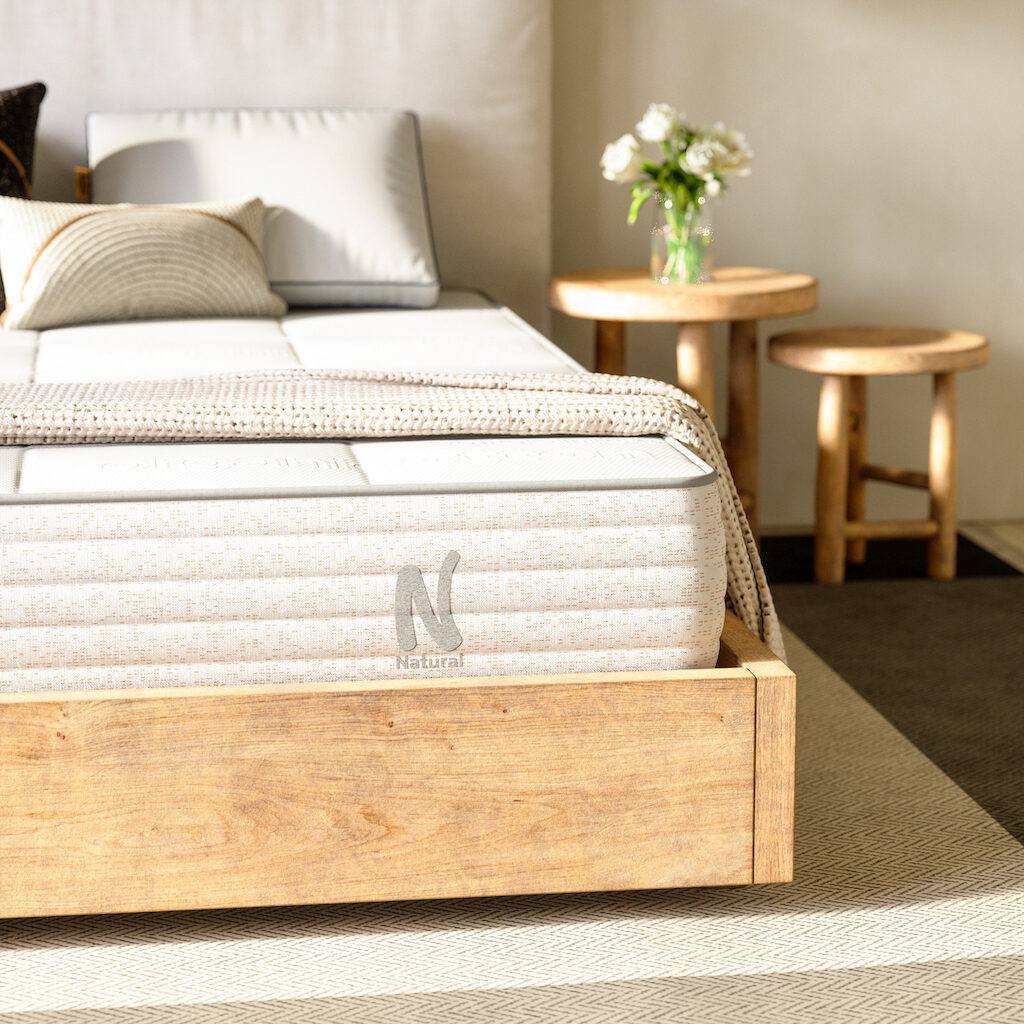
1. THE NOLAH NATURAL 11″ HYBRID MATTRESS
We reviewed it, slept on it for weeks, and our boss took it home. Simply the best Natural Latex Mattress we’ve seen. Cushy, immediately responsive support, reduces pressure substantially at shoulders and hips. For couples, great for snuggling in the middle with no digging your way out.
Individually pocketed coils for excellent edge support. Organic cotton, organic wool, and sustainably sourced pure botanical latex. Ten year warranty, 120 night trial. Two free “squishy” pillows you’ll fight over. $1199 in queen. The reviews on this mattress destroy the competition..consistently rated 4.9 out of 5 by actual owners.
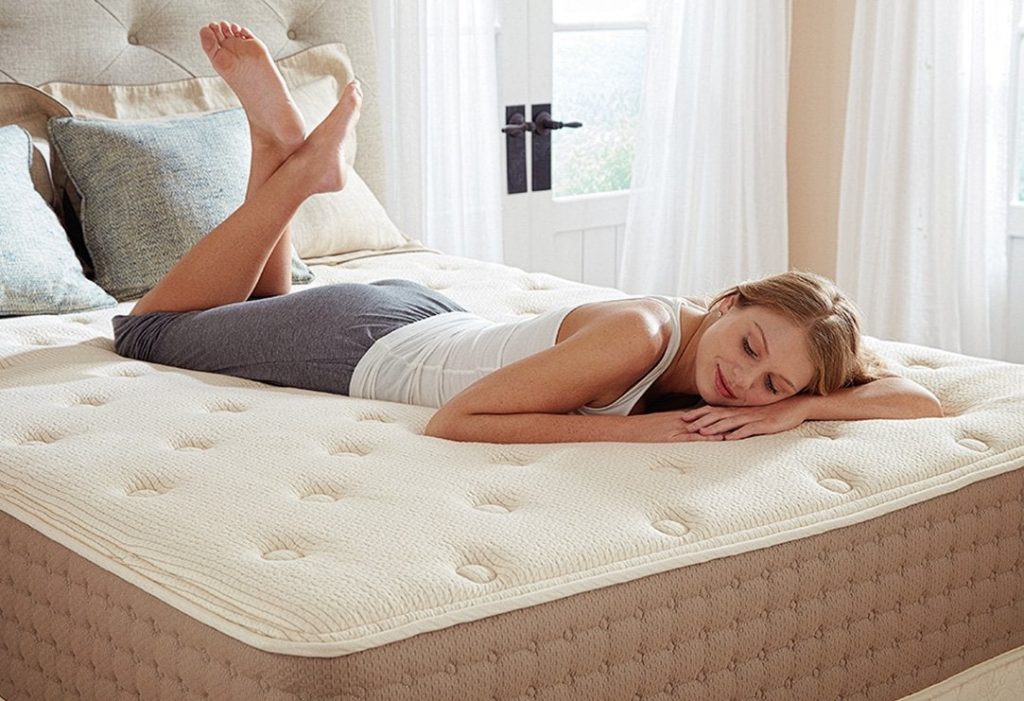
2. THE ECO-TERRA HYBRID LATEX MATTRESS
We love the quilted top piece on this natural latex and individually pocketed coil hybrid. Using GOTS certified latex, organic cotton, and organic wool, it’s a tad firmer than a typical natural latex mattress paired up with coils.
At 11″ tall, the queen version runs $1079, and you’ll get free shipping, 15 year warranty, and 90 day trial- with free returns. We like the label on this mattress, which discloses every singe ingredient in the mattress. Hand built in California, we’ve known and followed this company for almost 20 years.
A great option, excellent for back sleepers, and we found that it fills in little pockets and void areas very effectively.

3. LATEX FOR LESS: NO SYNTHETIC ANYTHING-FLIPPABLE, SO TWO MATTRESSES FOR PRICE OF ONE
Pure botanical latex, GOTS certified, uses 100% natural cotton cover, 100% natural wool fire barrier, all at a reasonable price. The mattress is reversible offering two firmness options, medium firm or medium plush.
Overall thickness is 9”, you’ll get a 120 night in home trial, a 20 year factory warranty, and their bed is completely made in the USA. Marc’s comments: They focus on delivering top drawer latex at controlled pricing.
Flippable, so two beds in one. Good call on this bed-no frills, but super low pricing option. Queen: $1099, no springs, just pure latex.
For the money, you essentially get two mattresses in one. There’s no formaldehyde, heavy metals, or other harmful agents in this mattress, so ideal for immune compromised individuals.
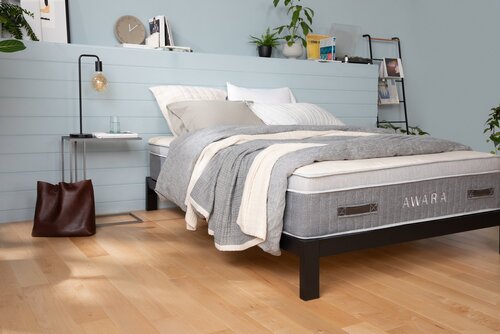
4. AWARA Organic Luxury Hybrid Mattress with Natural Foam & New Zealand Wool
This outstanding natural latex hybrid bed is stuffed with clean, chemical free ingredients and owners love them. You nest upon a breathable organic quilted top, and beneath you, your body floats on 4” of botanical Dunlop latex.
Individually pocketed coils suspend and hover you above the base layer of medium high density foam that won’t break down.
Delivered with 365 day no questions asked trial and FOREVER warranty! Now, how cool is that?
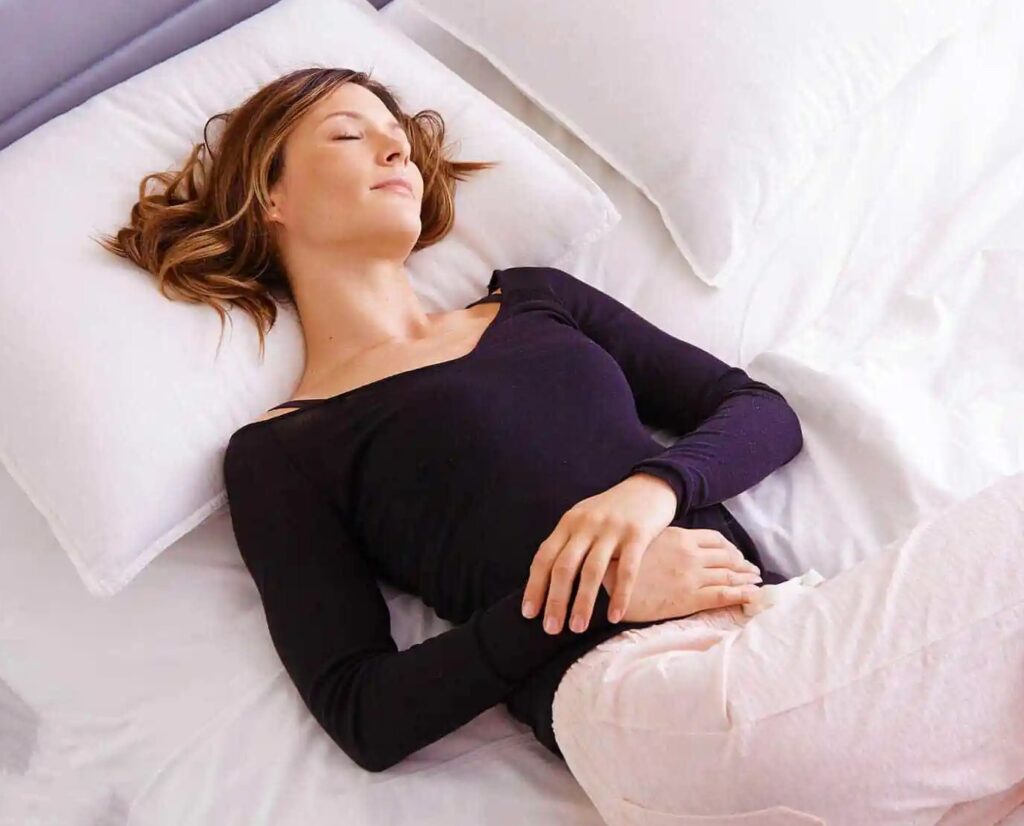
5. SAATVA LATEX HYBRID MATTRESS
At 12″ tall, and filled with a 3″ layer of organic latex, this luxury latex hybrid contains a pocketed coil system topped off with a hand tufted Euro top quilted organic cotton cover. Five ergonomic zones, I found the shoulder and hip pressure relief to be outstanding. $1895 in queen.
A 365 day trial, lifetime warranty, and free in home setup service underscores the appeal of my favorite online luxury mattress brand.
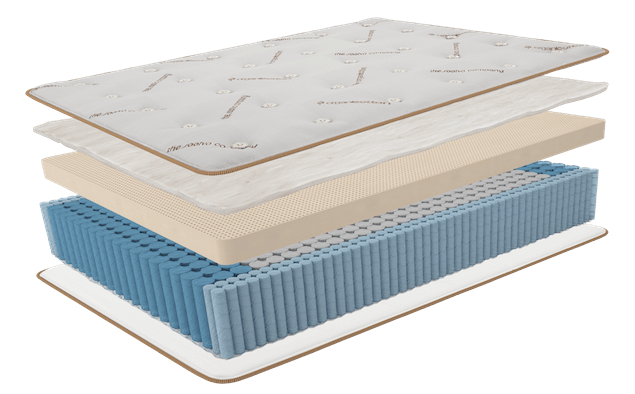
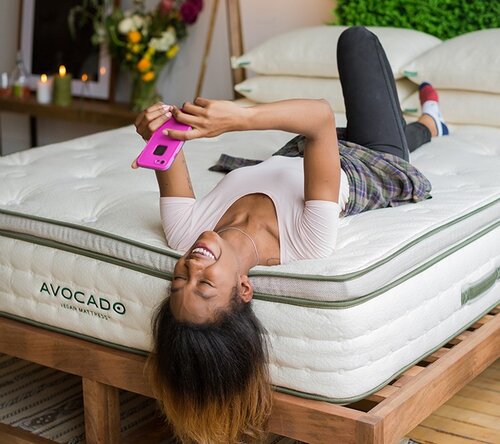
6. THE AVOCADO ECO-ORGANIC MATTRESS: CHEMICAL FREE SLEEP
Probably the cleanest, greenest, and safest bed you could buy. Made using only the finest natural and organic materials, including GOLS organic certified latex from tree-tapped sources, 100% GOTS organic certified wool and 100% GOTS organic certified cotton. To you, that means no-off gassing, or ghastly chemical textiles.
Note that this mattress is a bit more expensive, because it’s made top to bottom with pure latex only-no springs, no polyurethane foam. Queen $1299.
Made in California in their own factories, a purely American company. The latex used is imported from India, collected by hand, and is the silkiest and smoothest botanical latex available.

7. PLUSHBEDS BOTANICAL BLISS ORGANIC LATEX MATTRESS
If you are looking for zero synthetic materials in a mattress, this option is worth considering. Great company I’ve known for years. You can choose from 9″ or 10″ options with nothing but organic cotton, wool, and botanical latex.
You also get free sheets, pillows, and mattress protector. One of a handful of all natural, hypo-allergenic, truly chemical free mattress options left out there.
Choose either medium feel or medium firm, with yielding pressure relief and subtle bouncy feel. Left my hips and shoulders pain free when I tested my sample. Worth the money.
8. SAGE ORGANIC LATEX MATTRESS
At 11” overall thickness, this hybrid offers a combined 3″ of sustainably sourced Talalay latex, with a pocketed coil base.
Anti-microbial fabric up top with temperature regulating quilted organic wool, 120 day trial period, and it’s a good mix of soft and firm, falling at about 6 out of 10. Made entirely in USA, with a 20 year factory warranty.
It’s a bit pricey, but an example of getting what you pay for. Overall outstanding feel, excellent hip and shoulder support when on your side, also great for migraines, neck pain, and arthritis.
